2007 CHEVROLET IMPALA traction control
[x] Cancel search: traction controlPage 366 of 460

When It Is Time for New Tires
One way to tell when it
is time for new tires is
to check the treadwear
indicators, which will
appear when your tires
have only 1/16 inch
(1.6 mm) or less of
tread remaining.
You need a new tire if any of the following
statements are true:
You can see the indicators at three or more
places around the tire.
You can see cord or fabric showing through
the tire’s rubber.
The tread or sidewall is cracked, cut, or
snagged deep enough to show cord or fabric.
The tire has a bump, bulge, or split.
The tire has a puncture, cut, or other damage
that cannot be repaired well because of the
size or location of the damage.
Buying New Tires
GM has developed and matched speci�c tires for
your vehicle. The original equipment tires installed
on your vehicle, when it was new, were designed to
meet General Motors Tire Performance Criteria
Speci�cation (TPC Spec) system rating. If you need
replacement tires, GM strongly recommends that
you get tires with the same TPC Spec rating. This
way, your vehicle will continue to have tires that are
designed to give the same performance and vehicle
safety, during normal use, as the original tires.
GM’s exclusive TPC Spec system considers over
a dozen critical speci�cations that impact the
overall performance of your vehicle, including
brake system performance, ride and handling,
traction control, and tire pressure monitoring
performance. GM’s TPC Spec number is molded
onto the tire’s sidewall by the tire manufacturer.
If the tires have an all-season tread design,
the TPC Spec number will be followed by an MS
for mud and snow. SeeTire Sidewall Labeling
on page 352for additional information.
366
Page 368 of 460
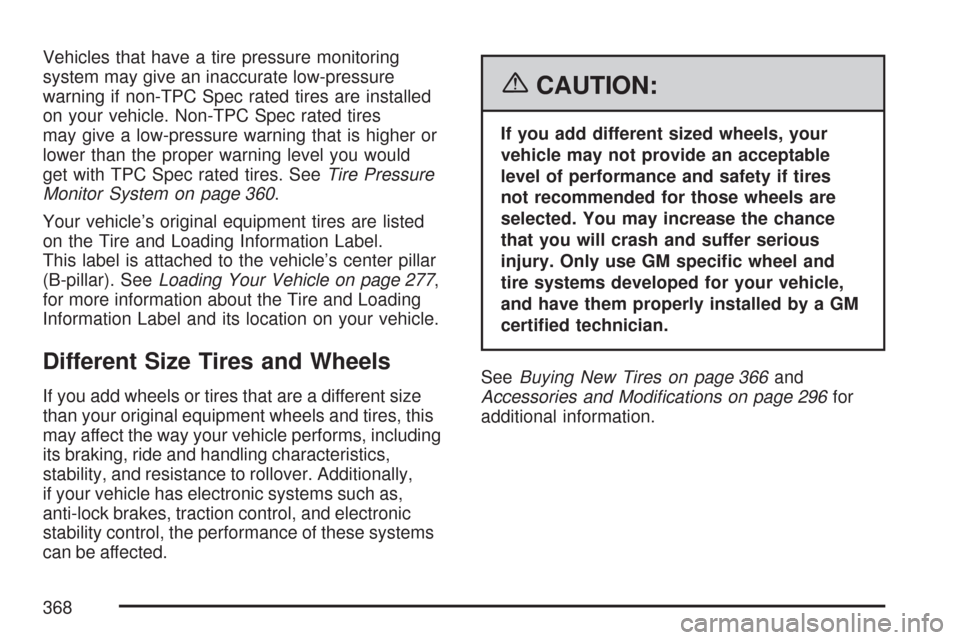
Vehicles that have a tire pressure monitoring
system may give an inaccurate low-pressure
warning if non-TPC Spec rated tires are installed
on your vehicle. Non-TPC Spec rated tires
may give a low-pressure warning that is higher or
lower than the proper warning level you would
get with TPC Spec rated tires. SeeTire Pressure
Monitor System on page 360.
Your vehicle’s original equipment tires are listed
on the Tire and Loading Information Label.
This label is attached to the vehicle’s center pillar
(B-pillar). SeeLoading Your Vehicle on page 277,
for more information about the Tire and Loading
Information Label and its location on your vehicle.
Different Size Tires and Wheels
If you add wheels or tires that are a different size
than your original equipment wheels and tires, this
may affect the way your vehicle performs, including
its braking, ride and handling characteristics,
stability, and resistance to rollover. Additionally,
if your vehicle has electronic systems such as,
anti-lock brakes, traction control, and electronic
stability control, the performance of these systems
can be affected.
{CAUTION:
If you add different sized wheels, your
vehicle may not provide an acceptable
level of performance and safety if tires
not recommended for those wheels are
selected. You may increase the chance
that you will crash and suffer serious
injury. Only use GM speci�c wheel and
tire systems developed for your vehicle,
and have them properly installed by a GM
certi�ed technician.
SeeBuying New Tires on page 366and
Accessories and Modi�cations on page 296for
additional information.
368
Page 369 of 460
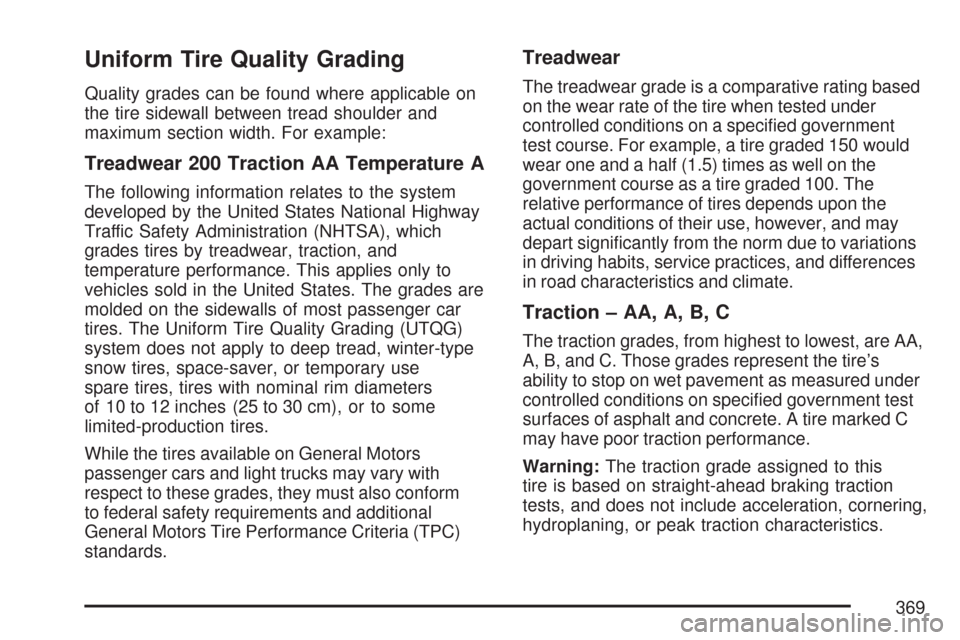
Uniform Tire Quality Grading
Quality grades can be found where applicable on
the tire sidewall between tread shoulder and
maximum section width. For example:
Treadwear 200 Traction AA Temperature A
The following information relates to the system
developed by the United States National Highway
Traffic Safety Administration (NHTSA), which
grades tires by treadwear, traction, and
temperature performance. This applies only to
vehicles sold in the United States. The grades are
molded on the sidewalls of most passenger car
tires. The Uniform Tire Quality Grading (UTQG)
system does not apply to deep tread, winter-type
snow tires, space-saver, or temporary use
spare tires, tires with nominal rim diameters
of 10 to 12 inches (25 to 30 cm), or to some
limited-production tires.
While the tires available on General Motors
passenger cars and light trucks may vary with
respect to these grades, they must also conform
to federal safety requirements and additional
General Motors Tire Performance Criteria (TPC)
standards.
Treadwear
The treadwear grade is a comparative rating based
on the wear rate of the tire when tested under
controlled conditions on a speci�ed government
test course. For example, a tire graded 150 would
wear one and a half (1.5) times as well on the
government course as a tire graded 100. The
relative performance of tires depends upon the
actual conditions of their use, however, and may
depart signi�cantly from the norm due to variations
in driving habits, service practices, and differences
in road characteristics and climate.
Traction – AA, A, B, C
The traction grades, from highest to lowest, are AA,
A, B, and C. Those grades represent the tire’s
ability to stop on wet pavement as measured under
controlled conditions on speci�ed government test
surfaces of asphalt and concrete. A tire marked C
may have poor traction performance.
Warning:The traction grade assigned to this
tire is based on straight-ahead braking traction
tests, and does not include acceleration, cornering,
hydroplaning, or peak traction characteristics.
369
Page 372 of 460
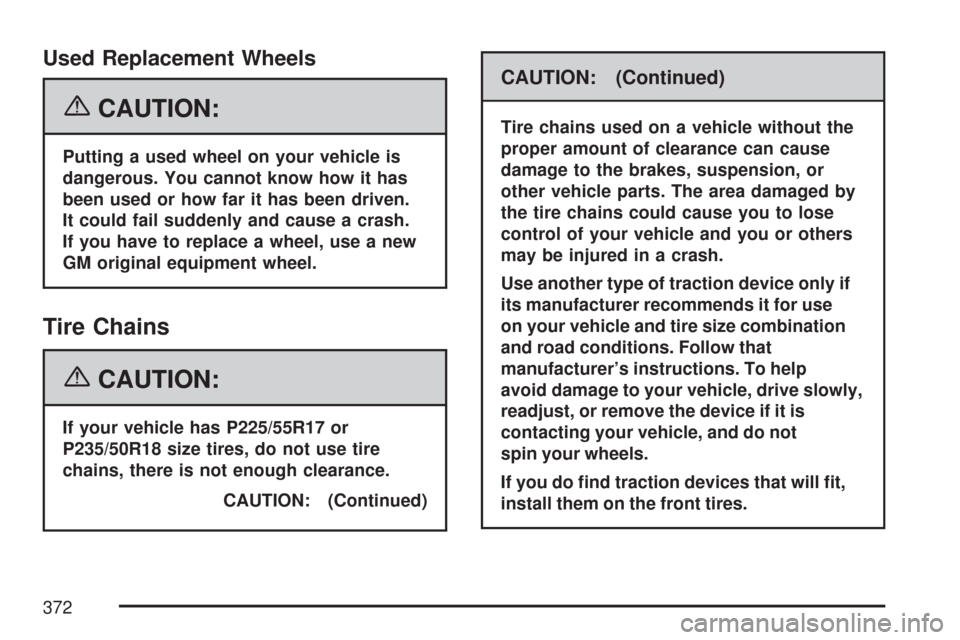
Used Replacement Wheels
{CAUTION:
Putting a used wheel on your vehicle is
dangerous. You cannot know how it has
been used or how far it has been driven.
It could fail suddenly and cause a crash.
If you have to replace a wheel, use a new
GM original equipment wheel.
Tire Chains
{CAUTION:
If your vehicle has P225/55R17 or
P235/50R18 size tires, do not use tire
chains, there is not enough clearance.
CAUTION: (Continued)
CAUTION: (Continued)
Tire chains used on a vehicle without the
proper amount of clearance can cause
damage to the brakes, suspension, or
other vehicle parts. The area damaged by
the tire chains could cause you to lose
control of your vehicle and you or others
may be injured in a crash.
Use another type of traction device only if
its manufacturer recommends it for use
on your vehicle and tire size combination
and road conditions. Follow that
manufacturer’s instructions. To help
avoid damage to your vehicle, drive slowly,
readjust, or remove the device if it is
contacting your vehicle, and do not
spin your wheels.
If you do �nd traction devices that will �t,
install them on the front tires.
372
Page 453 of 460
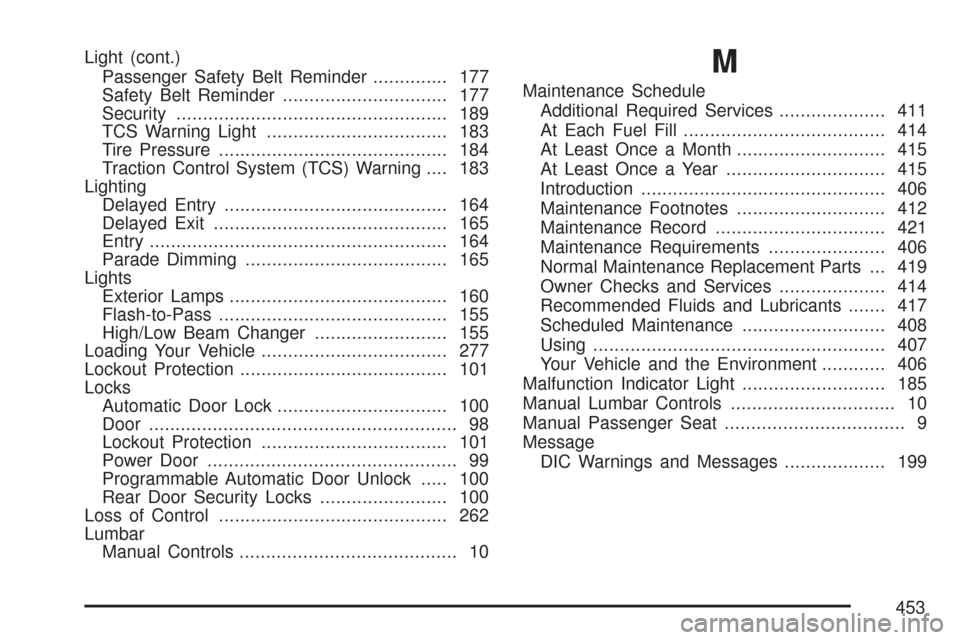
Light (cont.)
Passenger Safety Belt Reminder.............. 177
Safety Belt Reminder............................... 177
Security................................................... 189
TCS Warning Light.................................. 183
Tire Pressure........................................... 184
Traction Control System (TCS) Warning.... 183
Lighting
Delayed Entry.......................................... 164
Delayed Exit............................................ 165
Entry........................................................ 164
Parade Dimming...................................... 165
Lights
Exterior Lamps......................................... 160
Flash-to-Pass........................................... 155
High/Low Beam Changer......................... 155
Loading Your Vehicle................................... 277
Lockout Protection....................................... 101
Locks
Automatic Door Lock................................ 100
Door.......................................................... 98
Lockout Protection................................... 101
Power Door............................................... 99
Programmable Automatic Door Unlock..... 100
Rear Door Security Locks........................ 100
Loss of Control........................................... 262
Lumbar
Manual Controls......................................... 10M
Maintenance Schedule
Additional Required Services.................... 411
At Each Fuel Fill...................................... 414
At Least Once a Month............................ 415
At Least Once a Year.............................. 415
Introduction.............................................. 406
Maintenance Footnotes............................ 412
Maintenance Record................................ 421
Maintenance Requirements...................... 406
Normal Maintenance Replacement Parts ... 419
Owner Checks and Services.................... 414
Recommended Fluids and Lubricants....... 417
Scheduled Maintenance........................... 408
Using....................................................... 407
Your Vehicle and the Environment............ 406
Malfunction Indicator Light........................... 185
Manual Lumbar Controls............................... 10
Manual Passenger Seat.................................. 9
Message
DIC Warnings and Messages................... 199
453
Page 458 of 460
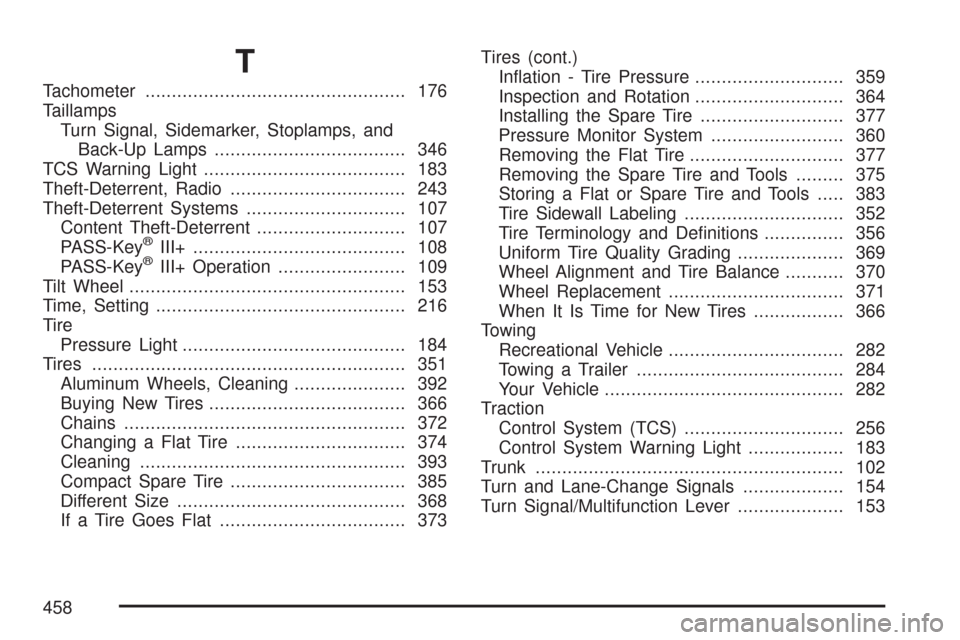
T
Tachometer................................................. 176
Taillamps
Turn Signal, Sidemarker, Stoplamps, and
Back-Up Lamps.................................... 346
TCS Warning Light...................................... 183
Theft-Deterrent, Radio................................. 243
Theft-Deterrent Systems.............................. 107
Content Theft-Deterrent............................ 107
PASS-Key
®III+........................................ 108
PASS-Key®III+ Operation........................ 109
Tilt Wheel.................................................... 153
Time, Setting............................................... 216
Tire
Pressure Light.......................................... 184
Tires........................................................... 351
Aluminum Wheels, Cleaning..................... 392
Buying New Tires..................................... 366
Chains..................................................... 372
Changing a Flat Tire................................ 374
Cleaning.................................................. 393
Compact Spare Tire................................. 385
Different Size........................................... 368
If a Tire Goes Flat................................... 373Tires (cont.)
In�ation - Tire Pressure............................ 359
Inspection and Rotation............................ 364
Installing the Spare Tire........................... 377
Pressure Monitor System ......................... 360
Removing the Flat Tire............................. 377
Removing the Spare Tire and Tools......... 375
Storing a Flat or Spare Tire and Tools..... 383
Tire Sidewall Labeling.............................. 352
Tire Terminology and De�nitions............... 356
Uniform Tire Quality Grading.................... 369
Wheel Alignment and Tire Balance........... 370
Wheel Replacement................................. 371
When It Is Time for New Tires................. 366
Towing
Recreational Vehicle................................. 282
Towing a Trailer....................................... 284
Your Vehicle............................................. 282
Traction
Control System (TCS).............................. 256
Control System Warning Light.................. 183
Trunk.......................................................... 102
Turn and Lane-Change Signals................... 154
Turn Signal/Multifunction Lever.................... 153
458